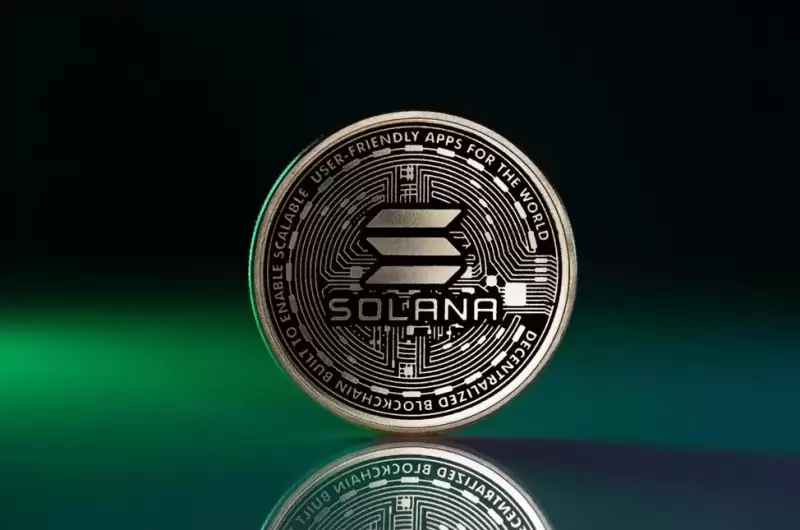 |
|
 |
|
 |
|
 |
|
 |
|
 |
|
 |
|
 |
|
 |
|
 |
|
 |
|
 |
|
 |
|
 |
|
 |
|
截至2025年4月,該基金會實施了一項政策,對於添加到其委派計劃(SFDP)的每個新驗證者,將刪除三個現有驗證者

Solana Foundation has adjusted its validator strategy to promote network decentralization and reduce reliance on its support. As of April 2025, the Foundation introduced a policy where, for every new validator added to its Delegation Program (SFDP), three existing validators are removed if they meet specific criteria.
索拉納基金會(Solana Foundation)調整了其驗證策略,以促進網絡分散化並減少對其支持的依賴。截至2025年4月,基金會介紹了一項政策,對於添加到其代表團計劃(SFDP)的每個新驗證者的政策,如果符合特定標準,則將刪除三個現有驗證者。
This policy, which began with the addition of Blockfolio to the SFDP, will see three existing validators removed. The departing validators are NodeReal, CCVC, and STiC Pay, leaving the SFDP with 15 validators.
該政策從向SFDP添加BlockFolio開始,將看到三個現有驗證者刪除。離職的驗證者是鼻狀驗證者,CCVC和Stic Pay,使SFDP擁有15個驗證器。
To be removed from the program, validators must have been in the SFDP for over 18 months and have less than 1,000 SOL in external stake. Moreover, they must not be a Node as they transition out of the program.
要從該計劃中刪除,驗證者必須在SFDP中持續了18個月以上,並且外部危險中只有不到1,000 SOL。此外,當他們從程序中過渡時,它們一定不能成為節點。
This move aims to encourage validators to attract independent stake and operate self-sufficiently. Concerns have been raised about many validators, in some cases up to 90-100% of their stake, relying heavily on Foundation backing.
此舉旨在鼓勵驗證者吸引獨立的股份並自給自足。人們對許多驗證者提出了擔憂,在某些情況下,其股份的90-100%依賴於基礎支持。
Research from Helius indicates that over half of Solana’s validators could become unprofitable without this support, highlighting the challenge of high on-chain governance costs. At present, smaller validators may struggle to maintain profitability and attract independent stake, potentially leading to consolidation or exits.
Helius的研究表明,如果沒有這種支持,Solana驗證者的一半以上可能會變得無利可圖,從而強調了高鏈治理成本的挑戰。目前,較小的驗證者可能難以維持盈利能力並吸引獨立的股份,可能導致合併或退出。
The policy is part of a broader effort to improve the Nakamoto Coefficient, a measure of decentralization, by reducing stake concentration. However, the Foundation has not yet responded to ongoing discussions about the policy’s impact.
該政策是通過降低損失濃度來改善中心化的中心化量度的更廣泛努力的一部分。但是,該基金會尚未回應有關該政策影響的持續討論。
By prioritizing validators with independent stake and phasing out those overly reliant on Foundation support, the policy aims to improve the Nakomoti Coefficient, reducing the risk of centralized control and enhancing network resilience.
通過使用獨立股份的驗證者優先考慮驗證者,並淘汰那些過於依賴基礎支持的驗證者,該政策旨在提高Nakomoti係數,從而降低集中控制和增強網絡彈性的風險。
Smaller validators, defined as those with less than 1,000 SOL in external stake, will be removed from the program after 18 months, which could render many unprofitable.
較小的驗證者(被定義為外部木樁少於1,000的驗證者)將在18個月後從該計劃中刪除,這可能會使許多人無利可圖。
With over half of validators potentially unviable without Foundation backing, according to Helius data, smaller validators may struggle to attract independent stake, leading to consolidation or exits.
根據Helius數據的數據,由於超過一半的驗證者在沒有基礎支持的情況下可能無法可行,因此較小的驗證者可能難以吸引獨立的股份,從而導致合併或退出。
This policy change is part of a broader shift in cryptocurrency toward on-chain governance, where token holders vote on network policies and upgrades.
這一政策變化是加密貨幣向鍊鍊政府進行更廣泛轉變的一部分,在該治理中,令牌持有人對網絡政策和升級進行投票。
Cardano introduced on-chain governance with the Chang hard fork in September 2024, establishing a model with separate governance branches, a legislative body, and a constitutional committee. ADA holders can delegate voting power to Delegate Representatives (DReps), who influence network decisions, including validator (stake pool) policies.
Cardano於2024年9月與Chang Hard Fork一起引入了鏈政治,建立了一個單獨的治理分支機構,一個立法機構和憲法委員會的模型。 ADA持有人可以將投票權委派給代表(DREPS),後者影響網絡決策,包括驗證者(股份池)政策。
Cardano’s stake pools are community-operated, with rewards tied to delegation from ADA holders. The governance model encourages decentralization by allowing token holders to choose stake pools, reducing reliance on centralized entities.
Cardano的股份池是社區經營的,獎勵與Ada Holders的代表團相關。治理模型通過允許令牌持有人選擇股份池,從而減少對集中實體的依賴來鼓勵權力下放。
Unlike Solana’s Foundation-driven staking, Cardano’s approach empowers the community to incentivize validators through delegation, fostering a competitive validator ecosystem.
與Solana的基礎驅動的Staking不同,Cardano的方法使社區能夠通過授權來激勵驗證者,從而促進競爭性驗證器生態系統。
This democratic model enhances decentralization but risks low voter turnout, potentially concentrating influence among active DReps or large ADA holders. Compared to Solana, Cardano’s governance is less centralized, as it lacks a foundation dictating validator inclusion, but it faces challenges in ensuring broad participation.
這種民主模式增強了權力下放,但風險冒著低選民的投票率,可能會在主動DREP或大型ADA持有人之間進行積極影響。與Solana相比,Cardano的治理較少集中,因為它缺乏基礎決定驗證者的包容性,但在確保廣泛參與方面面臨挑戰。
Polkadot’s OpenGov model, implemented in 2023, uses on-chain governance where proposals are written in code, voted on transparently, and executed automatically upon approval. Token holders vote on network upgrades and validator policies, increasing trust through deterministic processes.
Polkadot的OpenGov模型於2023年實施,該模型使用了鏈上治理,其中提案用代碼編寫,透明地投票並在批准後自動執行。令牌持有者對網絡升級和驗證者政策進行投票,通過確定性流程提高信任。
Validators in Polkadot are selected based on stake and performance, with nominators (token holders) choosing validators to back. The system incentivizes validators to attract independent stake, similar to Solana’s push for self-sufficiency. However, Polkadot’s governance is fully on-chain, contrasting with Solana’s off-chain Foundation-led decisions.
Polkadot中的驗證者是根據危險和績效選擇的,而提名人(令牌持有人)選擇驗證器返回。該系統激勵驗證者吸引獨立的股份,類似於Solana的自給自足。但是,Polkadot的治理是完全鏈的,與Solana的非鏈基礎主導的決定形成鮮明對比。
Polkadot’s transparent, community-driven model reduces centralized control compared to Solana’s Foundation policy. However, it requires active community participation, and “whale” token holders could dominate voting, mirroring Solana’s concern about stake concentration. Polkadot’s approach offers a more decentralized alternative but demands robust engagement to avoid governance capture.
與Solana的基礎政策相比,Polkadot透明的社區驅動模型減少了集中控制。但是,它需要積極的社區參與,“鯨魚”代幣持有人可以主導投票,這反映了Solana對股份集中的關注。 Polkadot的方法提供了一種更加分散的替代方案,但要求強大的參與以避免治理捕獲。
Ethereum relies on off-chain governance through Ethereum Improvement Proposals (EIPs), discussed in forums, conferences, and GitHub. Core developers, node operators, and miners (pre-Merge) or validators (post-Merge) reach consensus informally, with no formal on-chain voting.
以太坊通過以太坊改善建議(EIPS)(在論壇,會議和Github)中討論的以太坊改善建議(EIPS)依賴於鏈政府。核心開發人員,節點運營商和礦工(合併前)或驗證者(合併後)非正式地達成共識,沒有正式的鏈投票。
Since transitioning to Proof-of-Stake in 2022, Ethereum’s validators stake 32 ETH to participate, with rewards tied to performance. Unlike Solana’s Foundation staking, Ethereum has no central entity allocating stake; validators compete for community-driven delegation.
自從2022年過渡到股份證明以來,以太坊的驗證者32 ETH參加了參與,並與績效相關。與Solana的基金會不同,以太坊沒有中央實體分配股份。驗證者爭奪社區驅動的代表團。
The ecosystem encourages decentralization through protocols like Lido, though concerns persist about Lido’s dominance (controlling ~30% of staked ETH). Ethereum’s decentralized validator model avoids Solana’s centralized Foundation control but faces risks of stake concentration in large staking pools. Its off-chain governance allows flexibility but can be slow and contentious, as
生態系統通過Lido等方案鼓勵權力下放,儘管擔心Lido的主導地位(控制了約30%的Staked ETH)。以太坊的分散驗證器模型避免了Solana的集中基礎控制,但面臨著大型堆疊池中股權濃度的風險。它的離鏈治理可以靈活,但可能會緩慢而有爭議,因為
免責聲明:info@kdj.com
所提供的資訊並非交易建議。 kDJ.com對任何基於本文提供的資訊進行的投資不承擔任何責任。加密貨幣波動性較大,建議您充分研究後謹慎投資!
如果您認為本網站使用的內容侵犯了您的版權,請立即聯絡我們(info@kdj.com),我們將及時刪除。
-

- 比特幣優勢正在通過熟悉的模式進行,下一個目標可能為66%
- 2025-04-28 17:20:16
- 目前,交易者正在觀看的最大事情之一就是比特幣的主導地位,以及它如何通過一些非常熟悉的模式進行。
-

-

-

- 使用模型上下文協議有效地管理上下文
- 2025-04-28 17:20:15
- 在本教程中,我們通過構建ModelContextManager來指導您實現模型上下文協議(MCP)
-

-

- Solana(Sol)價格預測2025:SOL將超過其歷史最高的?
- 2025-04-28 17:20:13
- 全球加密市場繼續對2025年的Solana非常感興趣,被暱稱為SOL進行交易。
-

-

-

- BTC和ETH ETF以驚人的速度虧損
- 2025-04-28 16:55:13
- 上週,保羅·阿特金斯(Paul Atkins)宣誓就任美國證券交易委員會(SEC)的第34董事,繼承了最重的加密貨幣相關工作量






















































